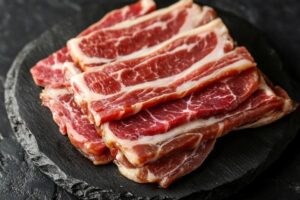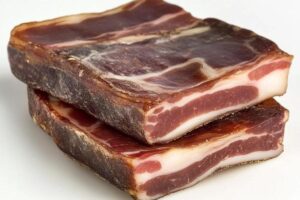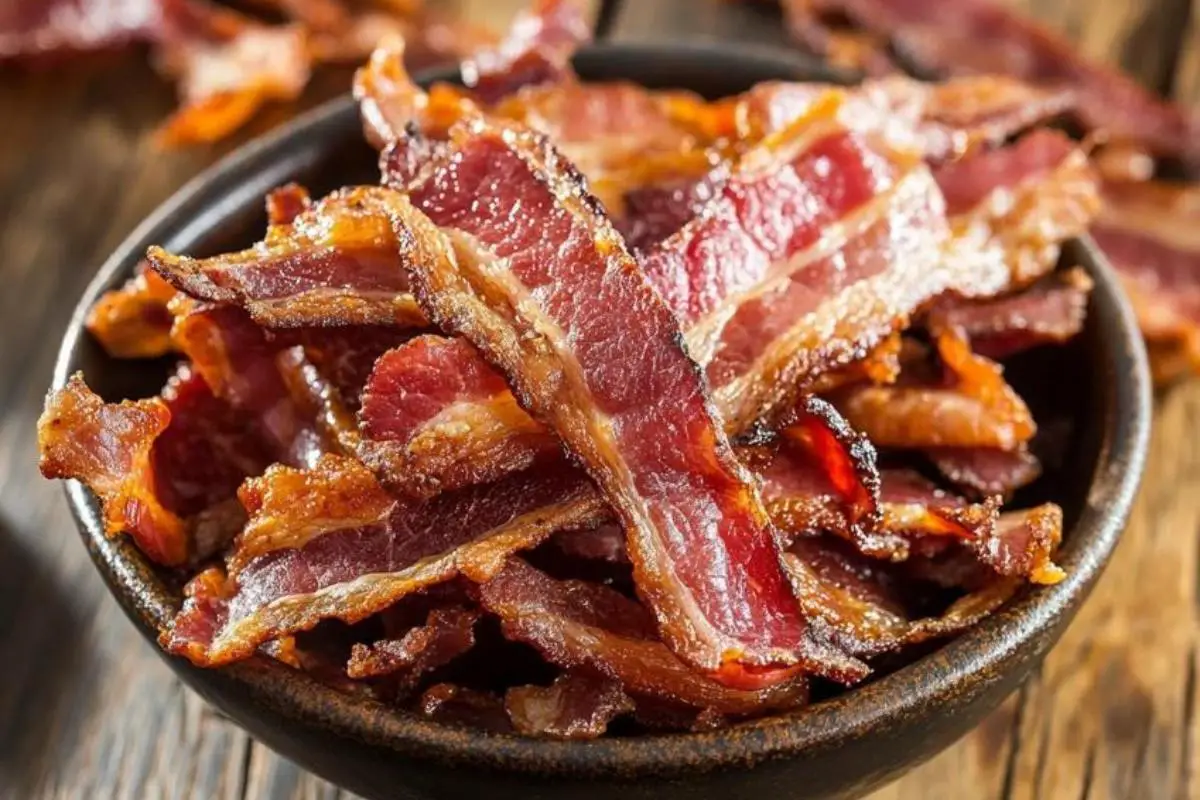Does Beef Bacon Taste Different? A Comprehensive Guide
Bacon is a staple of many breakfasts, but beef bacon is becoming a popular alternative. Does it really taste different from traditional pork bacon? This article explores everything you need to know about beef bacon, including its flavor, how it’s made, and why more people are trying it.
What is Beef Bacon?
Beef bacon is made from the belly or brisket of a cow instead of a pig. It goes through the same process of curing, smoking, and slicing, similar to pork bacon. The difference lies in the meat source.
- Beef bacon tends to be leaner.
- It’s a great choice for those who want less fat.
You can learn more about how beef bacon is made in this detailed explanation.
Does Beef Bacon Taste Different?
Yes, beef bacon does taste different from pork bacon. Here’s why:
- Flavor: Beef bacon has a richer, meatier flavor compared to pork bacon, which is milder and slightly sweet.
- Smokiness: Both types are smoked, but the smokiness in beef bacon is more intense.
- Texture: Beef bacon is leaner, which makes it crisper and less greasy than pork bacon.
Many people prefer beef bacon for its robust taste. You can read more about why some prefer beef bacon over pork bacon.
Nutritional Comparison: Beef Bacon vs. Pork Bacon
Many people switch to beef bacon because they believe it’s healthier. Let’s compare the two:
- Fat Content: Beef bacon usually contains less fat.
- Protein: Beef bacon has more protein per serving.
- Sodium: Both can be high in sodium, so check the labels.
Cooking Methods and Flavor Impact

How you cook beef bacon can significantly impact its flavor, texture, and overall enjoyment. Different cooking methods bring out unique qualities in the bacon, and each approach can highlight certain aspects of its smoky, meaty nature. Here’s a breakdown of popular cooking methods and how they affect the taste of beef bacon.
1. Pan-Frying
Pan-frying is the most common method of cooking bacon, and it works exceptionally well with beef bacon.
- Flavor impact: Pan-frying brings out the natural smokiness of beef bacon and allows the edges to crisp up nicely. The direct contact with heat helps render the fat, concentrating the flavor and creating a satisfying crisp.
- Texture: This method produces a crispy exterior while keeping some of the chewiness in the center, especially if you cook the bacon over medium heat to avoid drying it out.
- Tips: To enhance the flavor, season the bacon with black pepper or smoked paprika before frying. Don’t cook on high heat; moderate heat ensures even cooking without burning the leaner beef.
2. Baking
Baking is an excellent method for cooking beef bacon if you prefer an evenly crisp texture without the mess of frying.
- Flavor impact: Baking allows the bacon to cook slowly, which intensifies its smokiness and prevents the fat from becoming too greasy. You won’t get the same immediate sear as pan-frying, but the flavor remains consistent throughout the strips.
- Texture: Baking in the oven produces a uniform crispness. Since beef bacon is leaner than pork bacon, it can dry out faster, so it’s important to watch it closely near the end of the cooking time.
- Tips: Place the beef bacon strips on a wire rack over a baking sheet to let the fat drip off, ensuring the bacon remains crispy without being greasy. Bake at 375°F (190°C) for 15-20 minutes, flipping halfway through for even cooking.
3. Air-Frying
Air-frying is a healthy alternative to traditional frying that gives beef bacon a great crispy texture with less oil.
- Flavor impact: Since air-frying uses circulating hot air, it reduces the need for additional fat, resulting in a cleaner flavor. The smokiness is preserved, but the bacon is less oily and lighter on the palate.
- Texture: Air-frying delivers a super crispy texture, making it ideal for those who love their bacon extra crunchy. The rapid air circulation helps achieve crispness without over-drying the meat.
- Tips: Cook beef bacon in an air fryer at 350°F (180°C) for 8-10 minutes, shaking the basket or turning the strips halfway through. You can season the bacon lightly before cooking for an extra flavor boost.
4. Grilling
Grilling adds an additional layer of smokiness and char to beef bacon, giving it a more complex flavor profile.
- Flavor impact: Grilling beef bacon enhances its natural smoky flavor and imparts a subtle charred taste, similar to how a barbecue grill brings out the best in beef cuts. This method pairs well with marinades or seasonings like garlic, pepper, or BBQ rubs.
- Texture: Grilled beef bacon becomes slightly crisp on the outside while remaining juicy and flavorful on the inside. The open flame adds depth and complexity, making it an exciting option for bacon lovers.
- Tips: Place the beef bacon on medium heat, and cook for about 3-4 minutes per side. Keep an eye on it, as beef bacon cooks quickly on the grill and can burn if left unattended. If you prefer an extra smokey taste, use a smoker or add wood chips to your grill.
5. Microwaving
Microwaving beef bacon is the quickest and most convenient method, but it requires careful attention to avoid overcooking.
- Flavor impact: Microwaving can slightly diminish the smoky flavor because the bacon doesn’t get the same direct heat exposure as it would with other methods. However, it’s a fast way to prepare beef bacon, especially if you’re in a rush.
- Texture: This method produces a mix of crispy and chewy textures, depending on how thick the bacon is and how long it’s cooked. Since microwaving can sometimes lead to uneven cooking, some parts may be crisper than others.
- Tips: Place the beef bacon strips between two layers of paper towels to absorb excess grease. Microwave for 2-3 minutes on high, checking every 30 seconds to prevent overcooking. For even results, use a microwave bacon cooker.
6. Broiling
Broiling beef bacon under direct heat from the top of the oven can create a crisp texture with added caramelization.
- Flavor impact: Broiling intensifies the smokiness of beef bacon and caramelizes the edges, giving it a slightly sweet, smoky flavor. It’s a good option if you want to add extra flavor without additional oil.
- Texture: The broiler creates a crispy texture on the outside while leaving the inside tender. However, beef bacon can burn quickly under the broiler, so it’s important to monitor it closely.
- Tips: Preheat the broiler and cook the beef bacon on a broiling pan for about 3-5 minutes, flipping halfway through. Watch closely to avoid overcooking or burning.
Each cooking method brings out different aspects of beef bacon, allowing you to customize the flavor and texture based on your preferences.
- Pan-frying is best for those who want a crispy, smoky bacon experience.
- Baking and air-frying offer healthier alternatives while maintaining flavor and crunch.
- Grilling adds an extra smoky dimension, ideal for those who enjoy barbecue flavors.
- Microwaving and broiling are fast options but require careful attention to avoid overcooking.
Experiment with these methods to find the perfect way to cook beef bacon to suit your taste. Whether you prefer it crispy, chewy, or charred, beef bacon offers a versatile and flavorful alternative to traditional bacon.
Why Some Prefer Beef Bacon

There are several reasons why beef bacon has gained popularity and why many people prefer it over pork bacon and other alternatives. From dietary restrictions to health benefits and taste preferences, let’s explore why beef bacon has become a favorite for many.
1. Dietary Restrictions
One of the main reasons people switch to beef bacon is due to religious or cultural dietary restrictions:
- Kosher and Halal diets: Followers of kosher and halal dietary laws cannot eat pork. Beef bacon provides a savory, meaty alternative that aligns with these religious guidelines. It allows people to enjoy the flavor of bacon without violating their beliefs.
For those adhering to these restrictions, beef bacon is a perfect option, offering a delicious substitute that mirrors the smoking and curing process of pork bacon.
2. Health Considerations
Health-conscious individuals may prefer beef bacon because of its nutritional benefits:
- Lower fat content: Beef bacon is often leaner than pork bacon, especially when made from cuts like brisket or the beef belly. This makes it a better option for those looking to reduce their intake of saturated fats.
- Higher protein: For those following high-protein diets like keto or paleo, beef bacon provides more protein per serving than traditional pork bacon, making it a better choice for building muscle or maintaining a high-protein diet.
- Fewer calories: Due to its leaner nature, beef bacon typically contains fewer calories than pork bacon, making it an excellent choice for those who want a healthier alternative without sacrificing flavor.
3. Rich, Savory Flavor
Taste is a major factor in why some prefer beef bacon:
- Meatier taste: The robust flavor of beef bacon appeals to people who prefer a stronger, meatier taste. The natural richness of beef, combined with the smoky, cured flavors, gives beef bacon a bolder flavor than pork bacon, which tends to be milder and sweeter.
- Smokiness: Beef bacon often absorbs more of the smoke during the curing process, resulting in a deeper, more intense smoky flavor. This makes it ideal for people who enjoy strong, savory tastes.
4. Texture Preference
The texture of beef bacon is another key reason why some people prefer it:
- Crispier, leaner texture: Due to its lower fat content, beef bacon tends to be crispier and less greasy than pork bacon. Some people find this crunchier texture more enjoyable, especially if they prefer their bacon less fatty and less oily.
- Chewy yet crispy: Beef bacon strikes a balance between chewy and crispy. It retains the chewiness of beef while still crisping up nicely when cooked, offering a satisfying mouthfeel.
5. Unique Cooking Experience
Many people enjoy experimenting with beef bacon in the kitchen because it offers a unique cooking experience:
- Versatility: Beef bacon can be used in a variety of dishes, from breakfast platters to burgers and salads. Its rich flavor makes it a versatile ingredient that can be used in place of pork bacon in almost any recipe.
- Flavor pairing: Beef bacon pairs well with bold flavors like garlic, smoked paprika, and black pepper. Many people enjoy experimenting with different seasonings to bring out the best in beef bacon.
6. Sustainability and Ethical Reasons
Some people also prefer beef bacon for ethical or environmental reasons:
- Sustainability: Depending on the source, beef production can be more sustainable than pork, particularly if the cattle are grass-fed and raised on environmentally conscious farms. People who prioritize sustainability may choose beef bacon over pork for its potentially smaller environmental footprint.
- Ethical concerns: For individuals concerned about factory farming or animal welfare, sourcing beef bacon from local, grass-fed beef farms can provide a more ethical option compared to mass-produced pork bacon.
Many factors contribute to why some people prefer beef bacon over pork bacon. Whether it’s for religious reasons, health benefits, the rich and smoky flavor, or personal taste preferences, beef bacon offers a unique and satisfying alternative. Its leaner profile, combined with the robust, meaty flavor, makes it a popular choice among those looking for something new or healthier to enjoy.
If you haven’t tried beef bacon yet, it’s worth giving it a taste to see if it matches your preferences, especially if you love bacon but are looking for a richer, less fatty option.
Beef Bacon vs. Other Bacon Alternatives

While beef bacon is gaining popularity, there are several other bacon alternatives available. Let’s compare beef bacon with some of the most common alternatives, focusing on flavor, texture, and nutritional aspects.
Beef Bacon vs. Turkey Bacon
- Flavor: Beef bacon is much richer and has a stronger smoky, meaty taste compared to turkey bacon, which is often milder and less flavorful. Turkey bacon tends to lack the savory depth that beef bacon offers.
- Texture: Beef bacon tends to be crispier due to its lower fat content, whereas turkey bacon can sometimes be more rubbery or dry when overcooked. However, turkey bacon is generally leaner, making it a lighter alternative.
- Nutritional Content: Turkey bacon is often lower in fat and calories than beef bacon, making it a popular choice for those watching their fat intake. However, beef bacon offers more protein per serving, which can be a better option for high-protein diets like keto or paleo.
Beef Bacon vs. Chicken Bacon
- Flavor: Chicken bacon has an even milder flavor compared to beef and turkey bacon. It doesn’t have the smoky, robust flavor that beef bacon provides. Instead, it tastes more like grilled chicken, lacking the deep, savory notes found in beef bacon.
- Texture: Chicken bacon tends to be very lean, which makes it less crispy than beef bacon. It’s also less greasy, but the texture is closer to deli meats than traditional bacon.
- Nutritional Content: Chicken bacon is the leanest option of all the bacon alternatives. It’s low in fat and calories but also lower in protein compared to beef bacon. However, it can be a good choice for those looking for a lighter, low-fat option.
Beef Bacon vs. Vegan Bacon
- Flavor: Vegan bacon, made from ingredients like soy, tempeh, or seitan, differs completely in flavor. While some brands attempt to mimic the smoky flavor of traditional bacon, vegan bacon can’t replicate the rich, meaty taste of beef bacon. It often has a salty, smoky flavor but lacks the depth of beef bacon.
- Texture: The texture of vegan bacon varies widely depending on the brand, but it tends to be less crispy and more rubbery than beef bacon. Some versions can achieve a decent level of crispiness when cooked properly, but they usually lack the satisfying crunch of real beef bacon.
- Nutritional Content: Vegan bacon is usually low in fat and contains no cholesterol, making it a good option for vegetarians or vegans. However, it’s also lower in protein compared to beef bacon and may contain added preservatives or flavorings to mimic traditional bacon.
Conclusion: Choosing the Best Bacon Alternative
The choice between beef bacon and other bacon alternatives depends on your preferences for flavor, texture, and nutrition:
- If you want a rich, meaty flavor with a decent amount of crispiness, beef bacon is the best option.
- For a lighter, leaner alternative with a mild taste, turkey or chicken bacon might be more suitable.
- If you’re following a plant-based diet, vegan bacon offers a cruelty-free alternative, though it won’t replicate the taste or texture of beef bacon.
Each alternative has its pros and cons, but for those looking for a bold, savory flavor, beef bacon stands out among the rest.
Frequently Asked Questions (FAQs)
Does Beef Bacon Taste Like Pork Bacon?
Not exactly. Beef bacon is richer and more intense, while pork bacon is milder and slightly sweet.
Is Beef Bacon Healthier Than Pork Bacon?
Yes, it’s generally leaner and has more protein. However, it can still be high in sodium, so check the labels.
How Can I Make Beef Bacon Taste Better?
Season it with smoked paprika, black pepper, or garlic powder. Try marinating it before cooking for added flavor.
Where Can I Buy Beef Bacon?
Beef bacon is available in specialty grocery stores, butchers, and online retailers. It’s less common than pork bacon, but it’s growing in popularity.
Conclusion
Beef bacon is a flavorful alternative to pork bacon. It offers a richer taste, crispier texture, and can be a healthier option due to its leaner profile. Whether you’re looking to switch for dietary reasons or just to try something new, beef bacon is worth a taste. Experiment with different cooking methods and seasonings to find what suits your palate best.
External Resources to Learn More
- How Beef Bacon is Made – Learn about the beef bacon-making process.
- Why You Should Try Beef Bacon – Discover why many people prefer beef over pork bacon.
- Beef Bacon vs Turkey Bacon – A comparison of beef bacon and turkey bacon.

